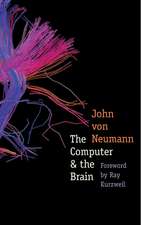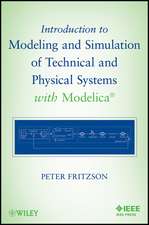Modeling Telecom Networks and Systems Architecture: Conceptual Tools and Formal Methods
Autor Thomas Muthen Limba Engleză Paperback – 12 noi 2012
| Toate formatele și edițiile | Preț | Express |
|---|---|---|
| Paperback (1) | 398.74 lei 6-8 săpt. | |
| Springer Berlin, Heidelberg – 12 noi 2012 | 398.74 lei 6-8 săpt. | |
| Hardback (1) | 406.42 lei 6-8 săpt. | |
| Springer Berlin, Heidelberg – 17 iul 2001 | 406.42 lei 6-8 săpt. |
Preț: 398.74 lei
Nou
Puncte Express: 598
Preț estimativ în valută:
76.30€ • 79.88$ • 63.13£
76.30€ • 79.88$ • 63.13£
Carte tipărită la comandă
Livrare economică 05-19 aprilie
Preluare comenzi: 021 569.72.76
Specificații
ISBN-13: 9783642631849
ISBN-10: 3642631843
Pagini: 480
Ilustrații: XXV, 450 p.
Dimensiuni: 155 x 235 x 25 mm
Greutate: 0.67 kg
Ediția:Softcover reprint of the original 1st ed. 2001
Editura: Springer Berlin, Heidelberg
Colecția Springer
Locul publicării:Berlin, Heidelberg, Germany
ISBN-10: 3642631843
Pagini: 480
Ilustrații: XXV, 450 p.
Dimensiuni: 155 x 235 x 25 mm
Greutate: 0.67 kg
Ediția:Softcover reprint of the original 1st ed. 2001
Editura: Springer Berlin, Heidelberg
Colecția Springer
Locul publicării:Berlin, Heidelberg, Germany
Public țintă
ResearchCuprins
1 Introduction to Systems Modelling.- 2 Foundations of Sysnet Modelling.- 3 Logical Network Modelling.- 4 Physical Network Modelling.- 5 Protocol Network Modelling.- 6 Process Control System Modelling.- 7 Concepts and Notations for Process Control Systems Modelling.- Appendix 1: List of Standards.- Appendix 2: Naming and Data Typing in AML.- References.
Recenzii
From the reviews of the first edition:
"Modeling is started to take on a great importance, but it still remains at the software component level. This book demonstrates the aspects of Sysnet Modeling (SM) and the Abstract system Modeling Language (AML). It is of great value and can be highly recommended to system architects, engineers and researchers. It is also a good book to design telecommunication systems that are responsive, intelligent, adaptive and autonomous." (Demetre Voukalis, Zentralblatt MATH, Vol. 1005, 2003)
"Modeling is started to take on a great importance, but it still remains at the software component level. This book demonstrates the aspects of Sysnet Modeling (SM) and the Abstract system Modeling Language (AML). It is of great value and can be highly recommended to system architects, engineers and researchers. It is also a good book to design telecommunication systems that are responsive, intelligent, adaptive and autonomous." (Demetre Voukalis, Zentralblatt MATH, Vol. 1005, 2003)
Textul de pe ultima copertă
The book describes a method for modeling systems architecture, in particular of telecom networks and systems, although a large part can be used in a wider context. The method is called Sysnet Modeling, and is based on a new modeling language, called AML (Abstract systems Modeling Language), that is also described in the book. By applying sysnet modeling and AML, a formal model of the system is cre-ated. That model can be used for systems analysis, as well as for communicating system knowledge to a broader audience of engineers in development projects. Inherent in sysnet modeling is also a potential for considerable reduction in time spent on system implementation, through the possibilities for code- and test-case generation.
Caracteristici
The book presents a modeling language and method that we well established in the Ericsson Research Group. This method handles the complexity within telecom networks, controlling the evolution of the models over time, supporting the natural phases of development in telecom systems, and separating different properties of the complex models. It's non-redundant and yet integrated in a coherent model of telecom syst.













